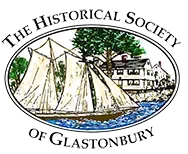The Town of Glastonbury was established in 1693. It was named for the town of Glastonbury in Somerset, England. The Historical Society is proud to feature the history of our town at the Museum on the Green, open Mondays, Tuesdays, and Thursdays from 10 a.m. to 4 p.m. Glastonbury was once home to the Wangunk people, Native Americans who lived in the central Connecticut River valley for hundreds of years. The Wangunk people remain but reside in other towns and areas of the country.
In 1634, at the request of the local sachem, or leader, colonists traveled from Watertown, Massachusetts to settle the town now known as Wethersfield. Within a few years, the settlers began to farm the east side of the “Greater River,” calling this area Naubuc Farms. By 1690, there were enough people residing here that they petitioned the General Court of Connecticut to form their own town. The petitioners’ request was granted, provided that they built a Meeting House to conduct town business and to have worship services and hired a minister for the church. In 1693, the Reverend Timothy Stevens began his ministry, and “Glassenbury” became an official town.
Our town was named for the town of Glastonbury in Somerset, England. The spelling of our town name varied until the mid-1800s when it was decided to conform to the “proper” English spelling. The thorn on our town seal is a replication of the Glastonbury thorn tree, which grows beside the Glastonbury Abbey.
Glastonbury continued to grow and thrive in the 19th century with waves of European immigrants from Italy, Poland, and Ukraine. Over two dozen sites in town tell tales of Glastonbury’s past. We still boast the oldest continuously operating ferry in the country. Cotton Hollow Park boasts the remains of the 5 story cotton mill that once operated there and has a marker commemorating the Revolutionary War powder mill that exploded, killing the owner, three of his sons, and several others. The Welles Chapman Tavern in the center of town was one of several taverns offering food and lodging to travelers on their way from Hartford to New London. Stone from the town’s quarry was used in the building of the Wadsworth Atheneum. The William Welles residence housed and educated some of Yale University’s students when they were threatened with conscription during the Revolutionary War. The language of the Wangunk people is evident throughout the town. Two elementary schools, Naubuc and Nayaug, are named after the village where the Wangunk people resided. Place names such as Minnechaug and Neipsic recall the different areas of the town named by the Wangunk when they lived here. The famous Smith Sisters spent their lives in Glastonbury and were famous for being staunch advocates for the abolition of slavery and then for women’s rights, especially the right to vote.
Our community has been enriched by all of the individuals and communities who have lived here and who continue to come to Glastonbury each year.

